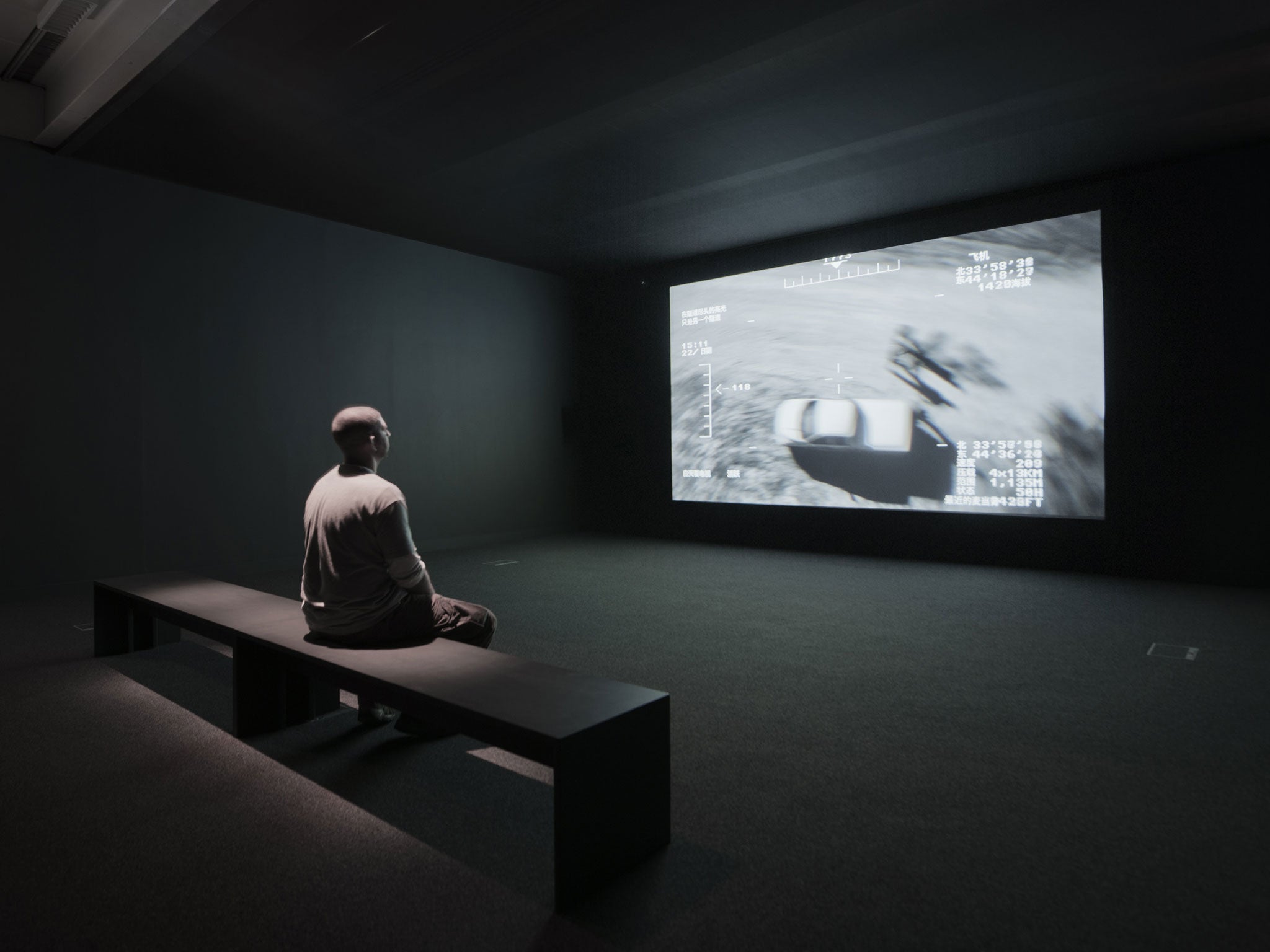Visual art review: 5,000 Feet is the Best - How truth and fiction became blurred
Why does fuzzy footage signify reality to us? And can we trust our eyes in a world where film is full of such clever tricks?

It doesn’t much matter when you walk into Omer Fast’s 30-minute film, 5,000 Feet is the Best, since, in a side-room at the Imperial War Museum, it runs on a continuous loop.
You may find yourself arriving part-way through an interview with an American drone pilot or looking at the Las Vegas night skyline, hearing the story of a man conned out of his trousers, or of a family killed by a missile. You won’t have to wait half an hour for these to come around again, as they are repeated several times, with variations, in each 30-minute segment, loops within loops. Fast’s 5,000 Feet is like Groundhog Day with bodies.
The resemblance may be meant, because before it is about anything else – geopolitics, US militarism, the morality of virtual warfare – Fast’s film is about film. It became a truism of 9/11 that TV footage of planes flying into towers felt unreal because it looked like disaster movie special effects. The deadliest act of terrorism in the history of the world was filtered, for those witnessing it, through Airport and Towering Inferno.
As long ago as 1977 and the Mars-landing movie, Capricorn One, the connection between Hollywood’s monopoly on the moving image and US world domination were linked, as though film were complicit in American power. Fast, a film-maker who was born in Israel and lives in New York, presumably has a personal interest in this history. The credibility of propaganda depends on the credibility of the medium that presents it. 5,000 Feet is endlessly credible, to the point where its believability is the thing that makes it unbelievable.
Why do we believe our eyes? Familiarity plays a part, and 5,000 Feet is familiar. If you’re averagely filmy, you can count off its genres on your fingers: documentary (the drone pilots talking to camera), docudrama (likewise), flashback (the stories of one man losing his pants and another hijacking a train), home video (the vacationing family setting out in a car, to be incinerated by a Hellcat missile), zombie horror movie (ditto), Groundhog Day (idem).
In Fast’s slippery lens, though, these old cinematic friends grow unfamiliar. The two drone pilots – one, discussing the best way to hit targets in Pakistan while sitting in a control room in Nevada, utters the phrase that gives Fast’s work its title – seem different from each other.
The first, photogenically haggard, is a character from a docudrama, a re-enactor of genuine events. His German-accented interviewer implies that drone operators aren’t real pilots. “So what?” snaps the man. “You’re not a real journalist.” He complains about the presence of a film crew in his hotel bedroom, Fast undermining the smoke and mirrors of cinema by filming its mirrors and smoke.
By contrast, the second drone pilot seems actual, documentary rather than docudramatic. As in leaked news items, his face is encryptically blurred. It is only as 5,000 Feet goes on that you realise that this second pilot’s credibility comes from the way he is filmed – that a blurry face and to-camera delivery mean “real” to us, whereas the props and staged script of the first pilot mean “unreal”, or “less real”.
Take Bugs Bunny. Elmer Fudd points his shotgun, Bugs runs off. To show this, a little white cloud and lines appear where he stood the frame before, possibly accompanied by a pyoinnnggg noise. None of these things happen in real life: they are merely cartoon conventions to designate flight. All the same, we don’t question their meaning. In the same way, blurred or pixellated faces mean truth; odd camera angles and tracking shots its opposite. It isn’t what we are shown that makes us believe. It is how we are shown it.
This makes Fast’s a more subtle film than I had imagined. The obvious analogy in 5,000 Feet is between US air force pilots killing drone targets 9,000 miles away in Afghanistan and men killing gooks on video consoles: “It’s like playing a single game every day but always sticking on the same level,” laments one fly-boy. The number of people for whom this comparison is directly relevant – a few dozen? – is small. The more general moral displacement it represents is, for Fast, the scary thing.
For drone pilots hunched over their monitors, death is something that happens far away, over there; to us, desensitising happens to drone pilots. And yet it becomes clear, as 5,000 Feet loops on, that nothing is clear – who is real and who is not, how different we are from them; who they are and, ergo, who we are. To be morally puzzled by films of people being morally puzzled by films is to make us part of the problem. I doubt, having seen 5,000 Feet is the Best, that you will ever look at the news in quite the same way again. But then that, I would guess, is the point.
To 25 Sept (iwm.org)
NEXT WEEK Charles Darwent goes to hell with Robert Rauschenberg at London’s A&D Gallery
Critic’s choice
Michael Landy, the artist famous for destroying all his possessions in a performance piece, has now turned his hand to sacred art. In Saints Alive, at the National Gallery, London (to 24 Nov) he has created seven large-scale sculptures of saints based on likenesses in the gallery’s collection. The images, which are made from recycled materials found in markets and boot sales, can be cranked into life using a foot pedal – an effect which seems suitably miraculous.

Join our commenting forum
Join thought-provoking conversations, follow other Independent readers and see their replies
Comments